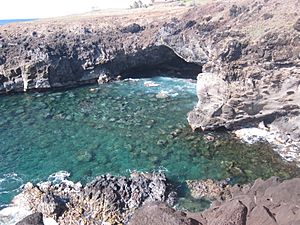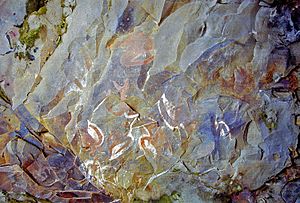Ana Kai Tangata facts for kids
Ana Kai Tangata (officially in Rapanui: Ana Kai Taŋata) is a cool sea cave on Easter Island. It's famous for its amazing rock art on the ceiling, especially paintings of birds called terns. You can find this cave near the Mataveri Airport, and it opens right up to the ocean waves. It's easy to get to and is one of the most popular caves to visit on Easter Island.
What is Ana Kai Tangata?
This special cave is made from volcanic rock. Over a long time, the ocean waves have slowly worn away the rock, creating the cave we see today. It's about 10 meters (33 feet) high, 5 meters (16 feet) wide, and goes back about 15 meters (49 feet) deep. Even though it faces the ocean, the cave floor is above the high tide line, so it's usually dry and easy to explore. The floor inside is covered with uneven rocks, and the ceiling is shaped like a dome, which gives it great sound qualities.
Amazing Cave Paintings
The cave paintings are done in red, white, and black colors. Most of them show the Manutara, which is a type of sooty tern bird. This bird was very important and considered sacred by people who followed the Birdman cult on Easter Island.
There are also pictures of boats. Some look like traditional Polynesian canoes, and others look like European ships. The islanders might have thought these ships were like messages from another world. The colors for these paintings came from plants and minerals found near the Ahu Vinapu area. These natural materials were mixed with shark oil to make the paints. Inside the cave, you can also find a taheta, which is a basin carved into a rock. People might have used this basin to mix their colors. Sadly, because of water leaking from above and salt from the ocean, the beautiful paintings are slowly fading.
What Does the Name Mean?
The cave is sometimes called "Cave of the Cannibals," but what the name truly means isn't perfectly clear. In the Rapa Nui language, ana means cave, and tangata means man. However, kai can have a few different meanings. An archaeologist named Georgia Lee suggested that the name could mean "cave where men eat," "cave where men are eaten," or even "cave that eats men."
This name might be connected to old legends that say cannibalism happened in the cave, but there isn't much proof. Some of these legends tell stories of battles where the losing side hid in caves, and then the winners captured them. It's also said that during the time of the Birdman cult, special gatherings might have taken place here. Bones from animals and humans have reportedly been found in the cave, adding to its mysterious past. This site was also known to have a carved ceremonial skull. The cave is also near the start of the Sendero Te Ara o Te Ao, which are trails that lead to important places like Rano Kau and Orongo.
See also
 In Spanish: Ana Kai Tangata para niños
In Spanish: Ana Kai Tangata para niños




